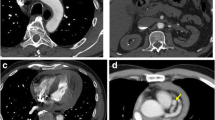Abstract
A 73-year-old woman with type III coronary perforation caused by failed angioplasty underwent emergency operation. It was impossible to stop the bleeding from the beating heart because the proximal Cx, which was the perforation site, was behind the main pulmonary artery. After establishing cardiopulmonary bypass, we separated the main pulmonary artery to secure hemostasis and performed coronary artery bypass grafting to the distal Cx. The postoperative course was uneventful therefore the patient was discharged on the tenth postoperative day. Surgical strategies are not standardized for coronary perforation and depend mainly on the surgical anatomy. In a situation like the present, which appears not to have been described previously, it is important to save the life of the patient by whatever means.


Similar content being viewed by others
References
Inoue Y, Ueda T, Taguchi S, Kashima I, Koizumi K, Noma S. Teflon felt wrapping repair for coronary perforation after failed angioplasty. Ann Thorac Surg. 2006;82:2312–4.
Nonomiya M, Tsuchida K, Kijima M, Matsumoto S, Kurosawa K. A successful treatment of coronary perforation associated with directional coronary atherectomy. Jpn Circ J. 1995;59:180–3.
Roberts CS, Bocanegra NR. Emergent operation for percutaneous coronary rupture after abciximab administration. Ann Thorac Surg. 2001;71:2024–6.
Bachar EO, Alex L, Jean-Marie DS. Off-pump treatment of coronary artery perforation after percutaneous intervention with a pericardial patch. Interact Cardiovasc Thorac Surg. 2005;4:509–10.
Ellis SG, Ajluni S, Arnold AZ, Popma JJ, Bittl JA, Eigler NL, et al. Increased coronary perforation in the new device era. Incidence, classification, management and outcome. Circulation. 1994;90:2725–30.
Shirakabe A, Takano H, Nakamura S, Kikuchi A, Sasaki A, Yamamoto E, et al. Coronary perforation during percutaneous coronary intervention. Int Heart J. 2007;48:1–9.
Chua SK, Lee SH, Shyu KG, Hung HF, Ling SC, Cheng JJ. Incidence, management, and clinical outcomes of procedure-related coronary artery perforation: analysis of 13,888 coronary angioplasty procedures. Acta Cardiol Sin. 2008;24:80–5.
Fukutomi T, Suzuki T, Popma JJ, Hosokawa H, Yokoya K, Inada T. Early and late clinical outcomes following coronary perforation in patients undergoing percutaneous coronary intervention. Circ J. 2002;66:349–56.
Fasseas P, Orford JL, Panetta CJ, Bell MR, Denktas AE, Lennon RJ, et al. Incidence, correlates, management, and clinical outcome of coronary perforation: analysis of 16,298 procedures. Am Heart J. 2004;147:140–5.
Seshadri N, Whitlow PL, Acharya N, Houghtaling P, Blackstone EH, Ellis SG. Emergency coronary artery bypass surgery in the contemporary percutaneous coronary intervention era. Circulation. 2002;106:2346–50.
Acknowledgments
My heartfelt appreciation goes to Prof. Tohru Asai, whose comments and suggestions were of inestimable value for my study. I would also like to express my gratitude to my family for their moral support and warm encouragement.
Author information
Authors and Affiliations
Corresponding author
Rights and permissions
About this article
Cite this article
Takashima, N., Suzuki, T., Hosoba, S. et al. Successful surgical management of coronary perforation requiring pulmonary artery separation. Gen Thorac Cardiovasc Surg 60, 581–583 (2012). https://doi.org/10.1007/s11748-012-0054-y
Received:
Accepted:
Published:
Issue Date:
DOI: https://doi.org/10.1007/s11748-012-0054-y




